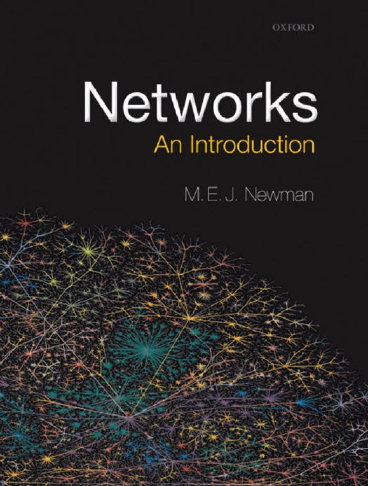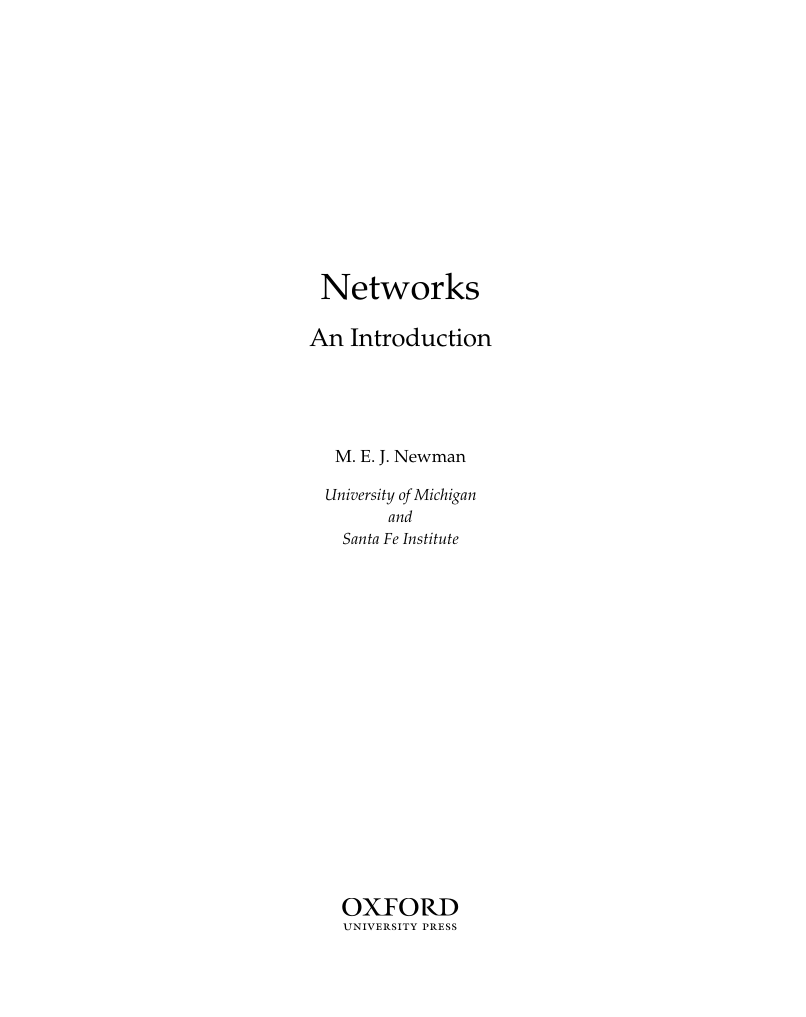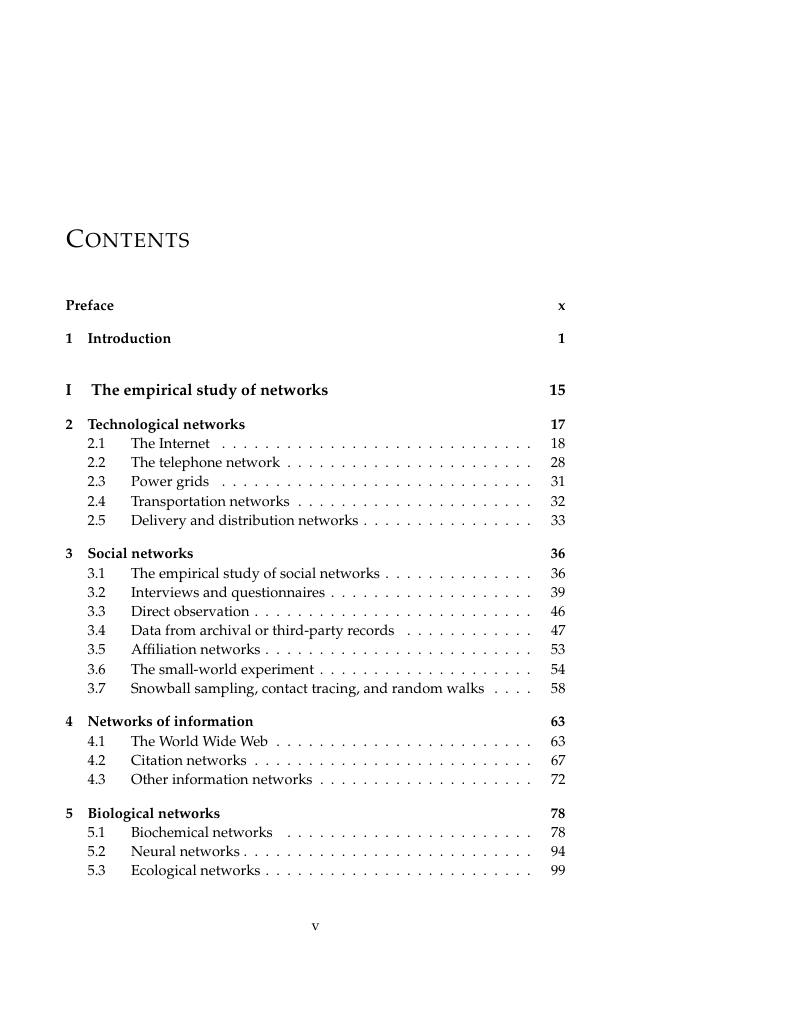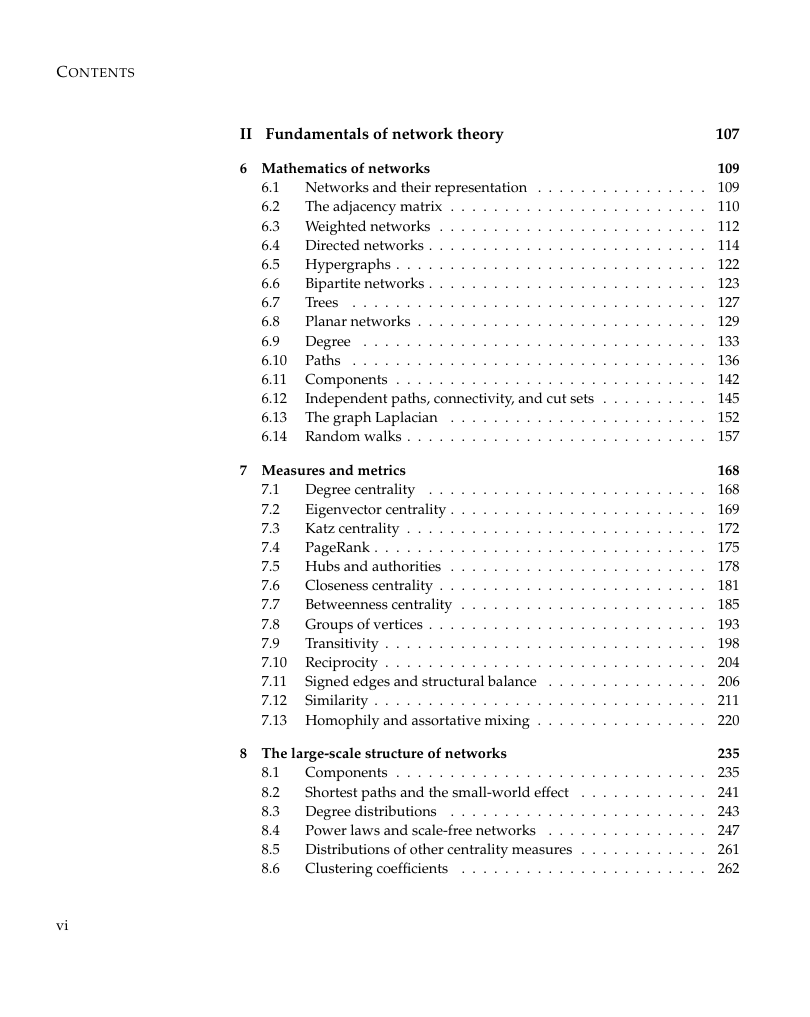Contents
Preface
1 Introduction
I: The empirical study of networks
2 Technological networks
2.1 The Internet
2.2 The telephone network
2.3 Power grids
2.4 Transportation networks
2.5 Delivery and distribution networks
3 Social networks
3.1 The empirical study of social networks
3.2 Interviews and questionnaires
3.3 Direct observation
3.4 Data from archival or third-party records
3.5 Affiliation networks
3.6 The small-world experiment
3.7 Snowball sampling, contact tracing, and random walks
4 Networks of information
4.1 The World Wide Web
4.2 Citation networks
4.3 Other information networks
5 Biological networks
5.1 Biochemical networks
5.2 Neural networks
5.3 Ecological networks
II: Fundamentals of network theory
6 Mathematics of networks
6.1 Networks and their representation
6.2 The adjacency matrix
6.3 Weighted networks
6.4 Directed networks
6.5 Hypergraphs
6.6 Bipartite networks
6.7 Trees
6.8 Planar networks
6.9 Degree
6.10 Paths
6.11 Components
6.12 Independent paths, connectivity, and cut sets
6.13 The graph Laplacian
6.14 Random walks
7 Measures and metrics
7.1 Degree centrality
7.2 Eigenvector centrality
7.3 Katz centrality
7.4 PageRank
7.5 Hubs and authorities
7.6 Closeness centrality
7.7 Betweenness centrality
7.8 Groups of vertices
7.9 Transitivity
7.10 Reciprocity
7.11 Signed edges and structural balance
7.12 Similarity
7.13 Homophily and assortative mixing
8 The large-scale structure of networks
8.1 Components
8.2 Shortest paths and the small-world effect
8.3 Degree distributions
8.4 Power laws and scale-free networks
8.5 Distributions of other centrality measures
8.6 Clustering coefficients
8.7 Assortative mixing
III: Computer algorithms
9 Basic concepts of algorithms
9.1 Running time and computational complexity
9.2 Storing network data
9.3 The adjacency matrix
9.4 The adjacency list
9.5 Trees
9.6 Other network representations
9.7 Heaps
10 Fundamental network algorithms
10.1 Algorithms for degrees and degree distributions
10.2 Clustering coefficients
10.3 Shortest paths and breadth-first search
10.4 Shortest paths in networks with varying edge lengths
10.5 Maximum flows and minimum cuts
11 Matrix algorithms and graph partitioning
11.1 Leading eigenvectors and eigenvector centrality
11.2 Dividing networks into clusters
11.3 Graph partitioning
11.4 The Kernighan–Lin algorithm
11.5 Spectral partitioning
11.6 Community detection
11.7 Simple modularity maximization
11.8 Spectral modularity maximization
11.9 Division into more than two groups
11.10 Other modularity maximization methods
11.11 Other algorithms for community detection
IV: Network models
12 Random graphs
12.1 Random graphs
12.2 Mean number of edges and mean degree
12.3 Degree distribution
12.4 Clustering coefficient
12.5 Giant component
12.6 Small components
12.7 Path lengths
12.8 Problems with the random graph
13 Random graphs with general degree distributions
13.1 Generating functions
13.2 The configuration model
13.3 Excess degree distribution
13.4 Clustering coefficient
13.5 Generating functions for degree distributions
13.6 Number of second neighbors of a vertex
13.7 Generating functions for the small components
13.8 Giant component
13.9 Size distribution for small components
13.10 Power-law degree distributions
13.11 Directed random graphs
14 Models of network formation
14.1 Preferential attachment
14.2 The model of Barabási and Albert
14.3 Further properties of preferential attachment models
14.4 Extensions of preferential attachment models
14.5 Vertex copying models
14.6 Network optimization models
15 Other network models
15.1 The small-worldmodel
15.2 Exponential random graphs
V: Processes on networks
16 Percolation and network resilience
16.1 Percolation
16.2 Uniform random removal of vertices
16.3 Non-uniform removal of vertices
16.4 Percolation in real-world networks
16.5 Computer algorithms for percolation
17 Epidemics on networks
17.1 Models of the spread of disease
17.2 The SI model
17.3 The SIR model
17.4 The SIS model
17.5 The SIRS model
17.6 Epidemic models on networks
17.7 Late-time properties of epidemics on networks
17.8 Late-time properties of the SIR model
17.9 Time-dependent properties of epidemics on networks
17.10 Time-dependent properties of the SI model
17.11 Time-dependent properties of the SIR model
17.12 Time-dependent properties of the SIS model
18 Dynamical systems on networks
18.1 Dynamical systems
18.2 Dynamics on networks
18.3 Dynamics with more than one variable per vertex
18.4 Synchronization
19 Network search
19.1 Web search
19.2 Searching distributed databases
19.3 Message passing
References
Index
A
B
C
D
E
F
G
H
I
J
K
L
M
N
O
P
Q
R
S
T
U
V
W
Y
Z
















 2023年江西萍乡中考道德与法治真题及答案.doc
2023年江西萍乡中考道德与法治真题及答案.doc 2012年重庆南川中考生物真题及答案.doc
2012年重庆南川中考生物真题及答案.doc 2013年江西师范大学地理学综合及文艺理论基础考研真题.doc
2013年江西师范大学地理学综合及文艺理论基础考研真题.doc 2020年四川甘孜小升初语文真题及答案I卷.doc
2020年四川甘孜小升初语文真题及答案I卷.doc 2020年注册岩土工程师专业基础考试真题及答案.doc
2020年注册岩土工程师专业基础考试真题及答案.doc 2023-2024学年福建省厦门市九年级上学期数学月考试题及答案.doc
2023-2024学年福建省厦门市九年级上学期数学月考试题及答案.doc 2021-2022学年辽宁省沈阳市大东区九年级上学期语文期末试题及答案.doc
2021-2022学年辽宁省沈阳市大东区九年级上学期语文期末试题及答案.doc 2022-2023学年北京东城区初三第一学期物理期末试卷及答案.doc
2022-2023学年北京东城区初三第一学期物理期末试卷及答案.doc 2018上半年江西教师资格初中地理学科知识与教学能力真题及答案.doc
2018上半年江西教师资格初中地理学科知识与教学能力真题及答案.doc 2012年河北国家公务员申论考试真题及答案-省级.doc
2012年河北国家公务员申论考试真题及答案-省级.doc 2020-2021学年江苏省扬州市江都区邵樊片九年级上学期数学第一次质量检测试题及答案.doc
2020-2021学年江苏省扬州市江都区邵樊片九年级上学期数学第一次质量检测试题及答案.doc 2022下半年黑龙江教师资格证中学综合素质真题及答案.doc
2022下半年黑龙江教师资格证中学综合素质真题及答案.doc